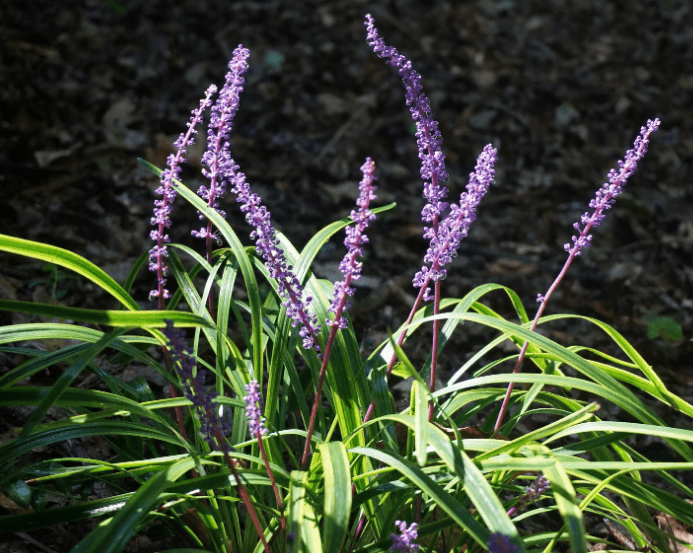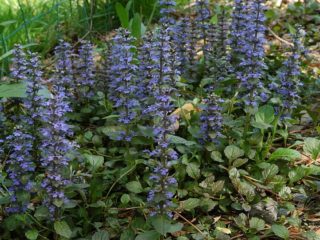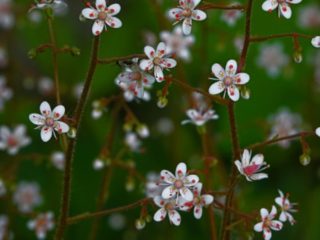Content
Liriope (lat. Liriope) is a herbaceous plant native to Asia. It got its interesting name for a reason. If you study the photo and description of liriope, then this is truly a unique plant with narrow and graceful leaves, with curved tops, reminiscent of the silhouette of the mystical creature Liriope, the mother of Narcissus and a character from ancient Greek mythology.
Description of the liriope plant
The liriope flower is a ground cover, perennial, belongs to the Liliaceae family, subfamily Nolinaceae. It is a spectacular ornamental plant for decorating the yard in the autumn season.

The flower is combined with other representatives of the flora, therefore it is often used in landscape design
Plant characteristics:
- has no stem;
- predominantly medium-sized - 0.70 m, there are also low-growing varieties - 20 m;
- the foliage is dense;
- evergreen;
- leaves up to 35 cm long, no more than 1.5 cm wide;
- inflorescences resemble spikelets of cereals;
- flowering begins in autumn and ends with the onset of frost;
- flowers are bisexual;
- roots fibrous, short;
- on the panicle many small flowers with yellow stamens are formed, shaped like lilies of the valley, lush, with a delicate aroma;
- after wilting, a seed box appears in place of the inflorescences, with seeds up to 7 mm, which are used for propagation.
Liriope is grown not only in garden plots; some varieties are suitable for indoor cultivation.

Liriope flower growing freely in the wild
Liriope varieties with photos
To date, more than 10 species of liriope are known. But only three of them are considered the most popular.
Liriope muscari (muscariform)
Liriope muscari is the most popular and widespread species, which has become the basis for the creation of various varieties and hybrids. The plant has a vertical root system consisting of intertwined roots and rootlets. The leaves are hard, dark green in color, narrow-linear in shape, with a pointed end.

Some subspecies have a yellow stripe in the middle of the leaf.
The peduncle is whorled, up to 0.7 meters long. Inflorescences appear in September-November; they are white or purple in color.
This species became the ancestor of many other varieties, with a bright and unique color:
- Christmas Tree;
Christmas Tree has bluish buds and wide leaves.
- Motley;
This liriope variety has yellow stripes on the leaves.
- Royal Purple;
The Royal Purple variety stands out with large purple flowers
- Majestic;
Majestic tolerates shade very well
- Fine-flowered;
The variety is characterized by a loose structure and purple inflorescences.
- Gold Banded;
Tall Gold Banded plant produces purple and blue flowers
- Monroe White;
Monroe White got its name from its tall white flowers.
- Big Blue;
Big Blue is decorated with lavender flowers
- Evergreen Giant with white inflorescences;
The variety is ideal for cold regions, as it tolerates low temperatures well.
Liriope spicata (grass-leaved)
Liriope spicata differs from its “brothers” in its resistance to frost. The root system is fibrous. As the name implies, liriope leaves are similar to the leaves of cereal crops. They have a dark green tint and a slightly wavy shape. Their length reaches 40 cm.
Liriope flower stalks are short, unobstructed by foliage, and white or purplish-gray. The inflorescences also look like spikelets and are colored pale blue. Flowering occurs in September-October.

The dark green foliage of the liriope flower is highly prized by landscape designers.
Liriope planifolia
Liriope platyphylla is a low-growing member of the family, developed from the Muscari variety. The leaves are bright green, elongated. The peduncles are blue, tightly covering the arrows of the peduncles. The bushes are miniature.

The flower was first described by Joao de Loreico from Portugal in 1790
Planting liriope in open ground
If the liriope has purple, lilac or blue flowers, then it is planted in a sunny place. If the flowers are white, then the plant will take root in partial shade, near tall bushes, under the canopy of trees.
Site preparation
Liriope prefers light soil that easily allows air and nutrients to pass through. Neutral or slightly acidic will do. In the spring, it is recommended to dig up the ground four weeks in advance and add humus and sand. If the soil is acidic, it is recommended to add a little wood ash or lime.
Landing technology
Planting in open ground is carried out in early spring. The recommended distance between holes is 0.4 m. The culture requires a hole with dimensions 2-3 times larger than the rhizome. The seedling is lowered into the hole, sprinkled with soil, lightly compacted and watered.
Caring for liriope in open ground
Caring for the flower is simple. The bushes grow quickly, creating a living carpet. The best place for planting is sunny, but with shade at midday. The plant is also undemanding when it comes to application. But during the growing season, it is recommended to always add formulations containing organic and mineral substances. The culture loves irrigation with warm water.
Watering
If the weather is hot outside, then you need to water the flower regularly. When cool weather sets in, moisturizing is reduced to twice a week. Do not allow moisture to stagnate near the roots. This is fraught with the appearance of rot on the roots and, as a result, the death of liriope.

After watering, the top layer of soil is loosened; in the evening, the plants can be irrigated with warm water over the leaves.
Top dressing
During the growing season, the liriope flower is fertilized once a week. Mineral and organic compositions are suitable. Before flowering begins, use nitrogenous fertilizers. During flowering, it is recommended to add potassium and phosphorus.
Trimming
Liriope does not require mandatory pruning. The procedure is carried out only to improve aesthetic appeal and give a neat appearance. A similar procedure is carried out with wilted foliage.
Transfer
In order for the liriope flower to constantly form new buds and not dry out, it should be replanted in a new place every three years. The procedure is recommended to be carried out in the spring at the beginning of May. The bush is dug up, divided into several parts and planted in a new place, watered abundantly.

The plant takes root completely in 2-3 weeks.
Overwintering of Liriope
The liriope flower is not afraid of moderate frosts down to -15 °C. Shelter is not required if the winter in the growing region is characterized by heavy snow. If the zone is harsh, then the plants are covered with fallen leaves and covered with non-woven material on top. After the snow has completely melted in the spring, the shelter is removed.

Without cultivation, the liriope bush becomes wild over time.
Reproduction methods
Liriope is propagated by dividing the bush or by seed. The last method is long and labor-intensive.
Seeds
Last year's seeds are used as seed material for the liriope flower. They do not require growing seedlings first. The seeds are simply immersed in the ground in early May.
Before planting, the seed is soaked in water and left for a day. The soil is also prepared, it must be cleared of weeds and dug up. Make small holes at a distance of about 10 cm from each other.
As soon as the emerging seedlings rise and get a little stronger, they undergo a picking procedure. This allows you to get rid of weak bushes.

Liriope flowers are planted in holes at a distance of 40-50 cm from each other.
By division
Reproduction by division is also carried out in early May, combined with transplantation. The soil is thoroughly moistened, the bush is dug up and divided into several parts. The main thing is that each division has at least 10 leaves, as well as a powerful root system.They are planted in a new place and watered abundantly. It is recommended to apply fertilizers once every 14 days during the first two months.
Diseases and pests
Liriope rarely gets sick, but this flower is very much loved by scale insects, aphids and snails. To get rid of pests, use the drug Actellica or wood ash.

Snails on the flower will have to be collected manually
The main problem that arises in a flower is root rot, which appears against the background of stagnation of water in the root system. Usually the disease occurs as a result of illiterate care.
To save the plant, it is simply transplanted to a new place. During the process, be sure to cut off all affected root shoots.
In addition, if not properly cared for, the plant may experience the following problems:
- Complete absence of buds on liriope or irregular flowering. Appears against the background of a lack of nutrients and severely depleted soil. To eliminate the problem, complex fertilizers are applied.
- If the flower lacks moisture, the tips of the leaves begin to dry out.
- limp leaves indicate that root rot has occurred.
Photos in landscape design
Liriope is ideal for creating a “living” border. The flower grows quickly.

To create a fence, plants are planted along the edges of the entire flowerbed at a distance of no more than 30 cm from each other.

The flower is suitable for demarcating garden paths

In the lawn, small Liriope species will fill the void between existing trees and shrubs
Conclusion
Judging by the photo and description of liriope, the plant is suitable for creating beautiful and unique flower beds. The variety of species allows it to be planted in a shady or sunny part of the land, and to be cultivated in regions with cold climates. The culture will delight with its flowering even at a time when all the other inhabitants of the flowerbed have faded.

















